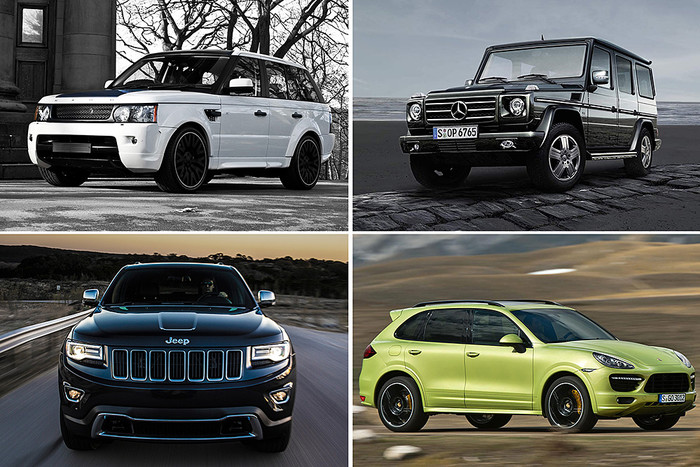
Do you know what these abbreviations mean?
Modern cars are simply crammed with various kinds of systems, the primary task of which is to increase safety and driving comfort. The latter are denoted by a few letter abbreviations that usually mean little to normal vehicle users. In this article, we will try not only to explain their meaning, but also to explain the principle of operation and location in vehicles offered by the most famous car manufacturers.
Common, but are they known?
One of the most common and recognizable systems that affect driving safety is the anti-lock brake system, i.e. ABS (eng. Anti-lock braking system). The principle of its operation is based on the control of wheel rotation, carried out by sensors. If one of them turns slower than the others, ABS reduces the braking force to avoid jamming. From July 2006, all new cars sold in the European Union, including Poland, must be equipped with ABS.
An important system installed on modern cars is the tire pressure monitoring system. TPMS (from eng. Tire pressure monitoring system). The principle of operation is based on monitoring tire pressure and alerting the driver if it is too low. This is done in most cases by wireless pressure sensors installed inside the tires or on the valves, with warnings displayed on the dashboard (direct option). On the other hand, in the intermediate version, tire pressure is not measured on a continuous basis, but its value is calculated based on pulses from the ABS or ESP systems. European regulations have made pressure sensors mandatory on all new vehicles starting in November 2014 (previously TPMS was mandatory on vehicles with run-flat tyres).
Another popular system that comes standard on all vehicles is the Electronic Stability Program, abbreviated ESP (jap. Electronic stabilization program). Its main task is to reduce the car's skidding when driving along road bends. When sensors detect such a situation, the electronic system brakes one or more wheels to maintain the correct trajectory. In addition, ESP interferes with engine control by determining the degree of acceleration. Under the well-known abbreviation ESP, the system is used by Audi, Citroen, Fiat, Hyundai, Jeep, Mercedes, Opel (Vauxhall), Peugeot, Renault, Saab, Skoda, Suzuki and Volkswagen. Under another abbreviation - DSC, it can be found in BMW, Ford, Jaguar, Land Rover, Mazda, Volvo cars (under a slightly expanded abbreviation - DSTC). Other ESP terms that can be found in cars: VSA (used by Honda), VSC (Toyota, Lexus) or VDC - Subaru, Nissan, Infiniti, Alfa Romeo.
Less known but essential
Now it's time for the systems that should be in your car. One of them is ASR (from the English Acceleration Slip Regulation), i.e. a system that prevents wheel slippage when starting off. ASR counteracts the slip of the wheels to which the drive is transmitted, using special sensors. When the latter detects a skid (slip) of one of the wheels, the system blocks it. In the event of an entire axle skid, the electronics reduce engine power by reducing acceleration. In older car models, the system is based on ABS, while in newer models, ESP has taken over the function of this system. The system is particularly suitable for driving in winter conditions and for vehicles with powerful powertrains. Called ASR, this system is installed on Mercedes, Fiat, Rover and Volkswagen. As TCS, we will meet it at Ford, Saab, Mazda and Chevrolet, TRC at Toyota and DSC at BMW.
An important and necessary system is also the emergency braking assistance system - BAS (from English Brake Assist System). Helps the driver in a traffic situation that requires an urgent response. The system is connected to a sensor that determines the speed of pressing the brake pedal. In the event of a sudden reaction from the driver, the system increases the pressure in the brake system. Consequently, full braking force is reached much sooner. In a more advanced version of the BAS system, hazard lights are additionally activated or brake lights flash to warn other drivers. This system is now increasingly a standard addition to the ABS system. BAS is installed under this name, or BA for short, on most vehicles. In French cars, we can also find the abbreviation AFU.
A system that improves driving safety is, of course, also a system EBD (Eng. Electronic Brakeforce Distribution), which is a brake force distribution corrector. The principle of operation is based on the automatic optimization of the braking force of the individual wheels, so that the vehicle maintains the selected track. This is especially useful when slowing down on curves in the road. EBD is an ABS booster system that in many cases is standard on new car models.
Worth recommending
Among the systems that ensure driving safety, we can also find systems that increase travel comfort. One of them is ACC (English adaptive cruise control), i.e. active cruise control. This is a well-known cruise control, supplemented by an automatic speed control system depending on the traffic situation. Its most important task is to maintain a safe distance from the vehicle in front. After setting a certain speed, the car automatically slows down if there is also a brake on the road ahead, and accelerates when it detects a free path. ACC is also known by other names. For example, BMW uses the term "active cruise control" while Mercedes uses the names Speedtronic or Distronic Plus.
Looking through folders with new car models, we often find the abbreviation AFL (Adaptive Forward Lighting). These are the so-called adaptive headlights, which differ from traditional headlights in that they allow you to illuminate corners. Their function can be performed in two ways: static and dynamic. In vehicles with static cornering lights, in addition to the normal headlights, auxiliary lights (such as fog lights) can also be switched on. In contrast, in dynamic lighting systems, the headlight beam follows the movements of the steering wheel. Adaptive headlight systems are most often found in trim levels with bi-xenon headlights.
It is also worth paying attention to the lane warning system. AFIL systembecause it is about it, warns of crossing the selected lane using cameras located in front of the car. They follow the direction of traffic, following the lines drawn on the pavement, separating the individual lanes. In the event of a collision without a turn signal, the system warns the driver with a sound or light signal. The AFIL system is installed on Citroen cars.
In turn, under the name Lane assist we can find it in Honda and cars offered by the VAG group (Volkswagen Aktiengesellschaft).
A system worth recommending, especially to those who frequently travel long distances, is Driver warning. This is a system that monitors driver fatigue by constantly analyzing how the direction of travel and the smoothness of the steering wheel movements are maintained. Based on the data collected, the system detects behaviors that may indicate driver drowsiness, for example, and then warns them with both a light and an audible signal. The Driver Alert system is used in Volkswagen (Passat, Focus), and under the name Attention Assist - in Mercedes (classes E and S).
They are (for now) just gadgets…
And finally, several systems that improve driving safety, but have various drawbacks - from technical to price, and therefore they should be treated - at least for now - as interesting gadgets. One of these chips BLIS (English Blind Spot Information System), whose task is to warn about the presence of a vehicle in the so-called. "Blind area". The principle of its operation is based on a set of cameras installed in the side mirrors and connected to a warning light that warns of cars in a space not covered by the exterior mirrors. The BLIS system was first introduced by Volvo, and is now available from other manufacturers - also under the name Lateral assistance. The main disadvantage of this system is its high price: if you choose the optional one, for example in Volvo, the cost of the surcharge is approx. zloty.
interesting solution too. City safety, that is, an automatic braking system. His assumptions are to prevent collisions or at least reduce their consequences to a speed of 30 km/h. It works on the basis of radars installed in the vehicle. If it detects that the vehicle in front is approaching quickly, the vehicle will automatically apply the brakes. Although this solution is useful in urban traffic, its main drawback is that it only provides full protection at speeds up to 15 km/h. This should change soon as the manufacturer says the next version will provide protection in the 50-100 km/h speed range. City Safety is standard on the Volvo XC60 (first used there), as well as the S60 and V60. In Ford, this system is called Active City Stop and in the case of the Focus costs an additional 1,6 thousand. PLN (only available in richer hardware versions).
A typical gadget is a traffic sign recognition system. TSR (English traffic sign recognition). This is a system that recognizes road signs and informs the driver about them. This takes the form of warnings and messages displayed on the dashboard. The TSR system can work in two ways: solely based on data received from the camera installed in the front of the car, or in an expanded form with a comparison of data from the camera and GPS navigation. The biggest drawback of the traffic sign recognition system is its inaccuracy. The system can mislead the driver, for example, by saying that it is possible to drive at a higher speed in a given section than is indicated by the actual road markings. The TSR system is offered, among other things, in the new Renault Megane Gradcoupe (standard on higher trim levels). It can also be found in most high-end cars, but there, its optional installation can cost several thousand zlotys.
It's time for the last of the "gadget" systems described in this article, with which - I must admit - I had the biggest problem when it came to classifying it in terms of usefulness. This is the deal NV, also abbreviated NVA (from English Night Vision Assist), called the night vision system. It is supposed to make it easier for the driver to see the road, especially at night or in bad weather. Two solutions are used in NV (NVA) systems, which use so-called passive or active night vision devices. Passive solutions use appropriately amplified available light. Active railroads - additional IR illuminators. In both cases, the cameras record the image. It is then displayed on monitors located in the dashboard or directly on the car's windshield. Currently, night vision systems can be found in many high-end and even mid-range models offered by Mercedes, BMW, Toyota, Lexus, Audi and Honda. Despite the fact that they do increase safety (especially when driving outside populated areas), their main drawback is a very high price, for example, you have to pay the same amount to retrofit a BMW 7 Series with a night vision system. like 10 thousand zł.
You can find out more about the systems and systems used in cars in our Motor cleaners: https://www.autocentrum.pl/motoslownik/
